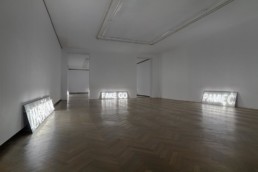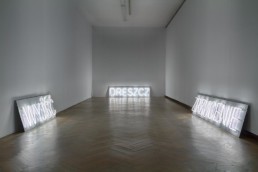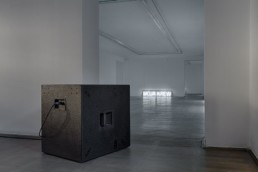Tomorrow will never come
installation in cooperation with Mirosław Bałka
curator: Marek Wasilewski
The Arsenal Municipal Gallery, Poznań, April 2017
Gdańsk City Gallery, Gdańsk, January 2017
The Arsenal Gallery in Białystok, November 2017
A light-sound composition engaging architecture and pre-existing elements of a gallery. A series of poetic slogans (single words, series of letters and signs) was produced in the technique of neon lamp and synchronised to sound of two subwoofers situated opposite one another, producing a pure tone at 42mHz frequency, cancelling one other out, and leading – uncontrollably – to occasional silences.
A starting point to the piece was a question about a sense of insecurity in an increasingly rapidly changing world; about a possibility of articulation of our desires and fears; the universally felt inflation of verbal signification in the public space; about aggression, demagogy and falsity of media and political discourses; slogans that are instruments of verbal bullying and domination by means of symbolic violence they carry; about linguistic and sign manipulations of emotions and needs.
The work was a question as to the meaning of words and signs with which we communicate, but not understand. The title of the exhibition suggested an impossibility of any further narrative, an impossibility of fulfilment of the future at the point of erasing the present. It also contains the paradox of impossibility of time determination: ‘tomorrow’ never comes, since from our point of view, every moment must be defined as a present moment, which results in an impossibility of both transgression and transcendence. Paradoxes related to imagining the future have been best captured by Richard Bardbrook, the author of Imaginary Futures (2009), in giving telling titles to its chapters: “The future is what it used to be” and “Those who forget the future are condemned to repeat it”. Barbrook demonstrated that the future is not a function of the past, but rather that imaginings of tomorrow are a theoretical, political and propaganda construct which has no chance of being fulfilled in reality to the extent to which we expect it.
As essential element of the exhibition was a process which lead to its emergence: a dialogue of artists and their search for a common ground, which would not be a compromise, but an opening of new possibilities. The effect was based in cooperation, negotiations and a pursuit of a novel quality, which would form a new constellation of significations. The exhibition yields at least a threefold reading: as a chaotic polyphony of voices, as a monologue, or as a dialogue. Its simple form opened the viewer up to a possibility of self-propelled navigation between signals and a novel construction of meanings.
[description based on a curatorial text]


